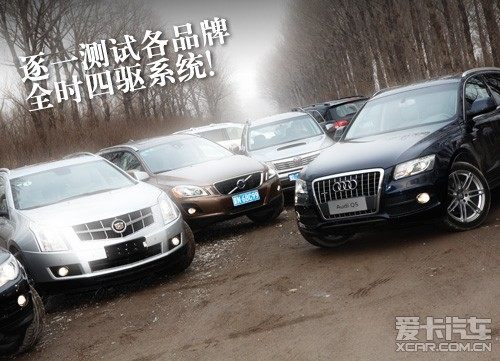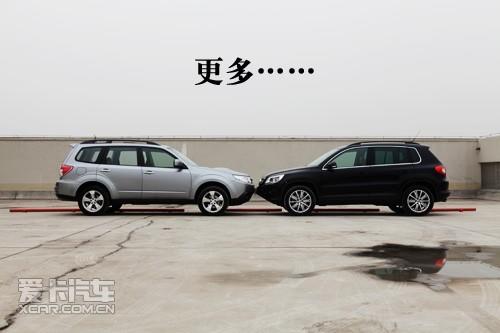Audi Q5 and Quattro with the reputation of four-wheel drive test.
Foreword: Perhaps it is our personality. When more than ten people stand in front of these eight cars, everyone’s excitement is self-evident. On the other hand, these SUVs, which respectively represent the so-called American, European and Japanese styles, occupy a completely different position in the hearts of every editor. Although it can be seen from everyone’s expressions that this is definitely an enjoyable test, we still want to emphasize here that the focus of this test is on each four-wheel drive system. Emphasis on the systematic characteristics of highway performance, fashionable appearance and load-bearing body, obviously they are not hard-core representatives in cross-country fans, but they are ideal choices closer to urban people.
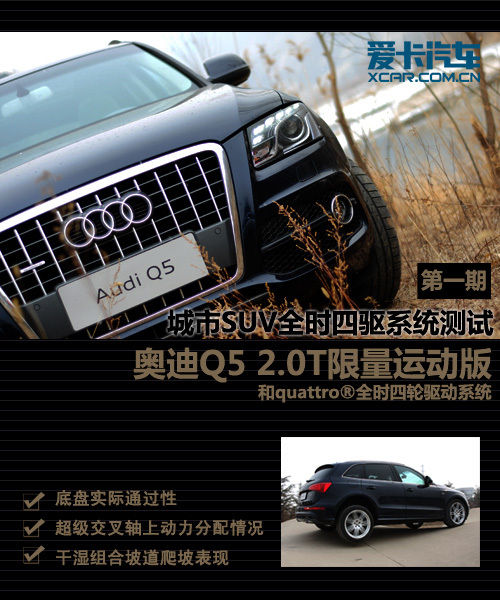






Review points in the past (click on the thumbnail to read directly)
Through the performance of each car on the spot, we have reason to refuse all kinds of paper talks, because many results will be beyond your expectation. Let’s take the lead in this test — — Audi Q5 2.0T limited edition sports edition and the famous quattro four-wheel drive system. Audi Q5 2.0T limited edition sports edition has a dynamic appearance and no cross-country style at all. The forward front axle not only makes it look much leaner than the elder brother Q7, but more importantly, the front suspension of Q5 is designed to be shorter than that of many opponents, which will bring it a larger approach angle.
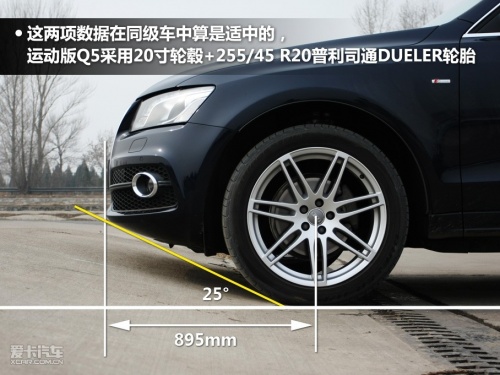
In the field test, you will find that "whether the wheel suspension system can effectively lock and distribute power reasonably" is another story, provided that you can drive up the slope first. Although this sounds a bit ridiculous, it is indeed a very important prerequisite for "outdoor sports". Generally speaking, the slightly sedan Q5 front bumper is visually heavy, but there is no problem in entering the venue smoothly. If there’s no problem, take the rough road first!

Speaking of which, we need to look at the parameters of Q5′ s height from the ground. According to the data, the minimum ground clearance of Q5 is 185mm, which is not particularly small, so we have to assume that its wheelbase has somewhat dragged down its hind legs. Everything has its advantages and disadvantages. Originally, due to the long wheelbase and balanced counterweight brought by the forward movement of the front axle, Q5 suffered a little loss here. Finally, another colleague, under the command of the people outside the car, barely passed the area by taking the wheel on one side first. However, we can clearly see from the photos that the space left in the chassis is also very small.




Q5 actually passed the performance test.
“quattro”— — It may be the first instinct of many people to hear the four-wheel drive system. Of course, I don’t think it is necessary to talk about the origin of "quattro" or anything else here. The actual performance of the system itself on the imported Audi Q5 is the most important. Compared with rough roads, I wonder if these test vehicles, if they have life, will be a little scared to look at such a high cross-axis road? To tell the truth, such a harsh road surface is not suitable for these city SUVs with load-bearing bodies to challenge, but in order to clearly present the working state of their four-wheel drive system, the cross axle is today’s "compulsory subject".
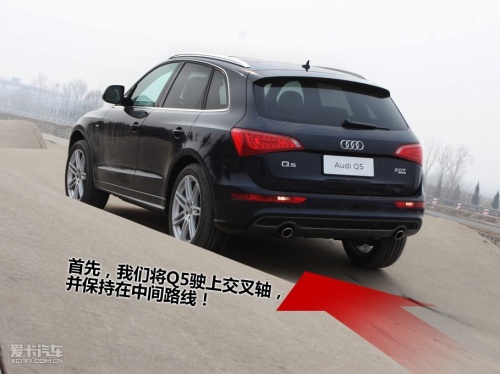
__________________________________________________________________________________
Cross axis:In the previous test project mainly aimed at hard-core off-road vehicles, because the wheels will be off the ground when the wheels on both sides are in different height drop positions, the way of power distribution of the four-wheel drive system of the vehicle can be clearly seen at this time, and the electronic system carried by the vehicle can be triggered to test whether the electronic system of this kind of urban SUV can play an obvious role.

__________________________________________________________________________________
Q5′ s performance in the cross-axis project test is not very good, but it is not difficult to pass the project with the reliability of quattro four-wheel drive system. Q5 didn’t expose any defects of quattro four-wheel drive system when starting to cross the axle, and everything of the vehicle remained normal. Only Q5′ s suspension stroke was short, and soon the wheels were suspended. At this time, we found that quattro four-wheel drive system can distribute power to the front and rear axles as required (Torsen differential can distribute 65% power to the front axle or 85% power to the rear axle at most in the limit state).


When the wheels off the ground idling, Q5′ s electronic system didn’t take any measures to control the idling tires, and of course, it didn’t transmit all the power to the two wheels with grip. From this, we can see that the Audi quattro four-wheel drive system can distribute the power between the front and rear axles in the limit state, but the electronic system is dragging its hind legs. When Q5 chooses the middle route of the cross axle (the route with the smallest difference between the front and rear), it can only barely pass.


Cross-axle test Q5 four-wheel power distribution
Then we increased the difficulty and let the vehicle drive on the left side of the big hump. The undulating angle of this road surface is larger and more difficult. At the beginning, Q5′ s performance was relatively stable. However, when the cross-axle wheels were off the ground, Q5′ s electronic auxiliary system still didn’t help us lock the idling wheels. It can also be seen that the electronic system equipped with Q5 for our test drive didn’t have EDL (electronic differential system) function. Facing the big gradient, Q5 relies on Torsen differential to distribute more power to the rear axle with strong grip, but at this time, it needs a big foot throttle to keep the vehicle moving forward, and it is not easy to pass this project.




After "hard work", Audi Q5 still stumbled through this section, and our test driver quickly returned the car to the central area of the cross axle. To sum up, in the whole quattro four-wheel drive system, the Torsen differential still completed its mission, and let the only two wheels push the car up the steep slope with difficulty, but we didn’t see any electronic system coming out to brake the idling wheels, which directly affected the more reasonable distribution of power and led to the Q5′ s performance here being a little ordinary and somewhat unexpected. Let’s review the whole process by video.

Driving on one side of the cross shaft almost stumbles Q5.
"Can your SUV climb a hill?" This topic seems to be very popular some time ago. In fact, it doesn’t necessarily need a big slope. We use a simpler method to test whether each four-wheel drive system can overcome the slippery slope. We paved a 10-meter-long rubber mulching film on a slope of about 15, and sprinkled a lot of soapy water on it to simulate a slippery road surface. During the test, we put the two wheels on the left side of the vehicle on the plastic film, and the right side still touches the ground normally. The test vehicle climbs the hill only by the driving force of two wheels on one side. Through this test, we can reflect the help of four-wheel drive system to our driving after snow.

Q5 performed well in this project. When stepping on the accelerator for about 30% at the start, two hungry tires on the left side of the road slipped slightly, but the ESP system immediately intervened to brake the slipping wheels with ABS, so as to reduce the wheel speed and make the wheels form rolling friction with the ground as much as possible, so as to prevent the wheels from idling and slipping, and make the tires on the wet road give full play to their grip as much as possible. Later, we tried to start at various throttle depths, and the electronic system could intervene to help us in time. After repeated experiments and splashing soapy water many times, Q5 could climb the ramp smoothly without any ambiguity.



After the ESP electronic system was turned off, we tested it again. At this time, we found that the electronic system of Q5 could not be completely turned off only by the switch on the center console. In an emergency, the electronic stability system will still help us to brake the tires that slip and idle, so that the vehicle can drive up the hill smoothly in this state. It can be seen that Audi’s quattro four-wheel drive system will perform better when all four wheels have grip, and the electronic system will work more actively, which is of great help to the driving performance of the vehicle.


Challenge the 15 slippery slope
You’re welcome to say, when you reach the high-speed pile-piercing area of this flat land, you can really reach the home of Audi Q5. For the Audi Q5, the high-power version of the 2.0T engine is the source of abundant power, which is also a great attraction for editors to compete for driving the Q5. The details such as the Bridgestone tire equipped with model 255/45R20 have become the places we appreciate in the pile-winding test.


Audi’s driving mode option is definitely one of the most worthy configurations, because by choosing three driving modes, you can really get three completely different driving experiences. In the pile-winding test, all options must be adjusted to "dynamic" mode, and the driving computer makes Q5 one of the most interesting SUVs by adjusting the engine, gearbox, steering and suspension system.

The change of steering and suspension system is obvious. The steering wheel diameter of Q5 is very small, and the precise steering system in sports mode greatly facilitates the driver’s control. Although the suspension system has been strengthened, it still has a certain tilt when it is around the pile, but it is much more obvious to stand outside the car than to sit in the car. In order to take care of the comfort of daily driving, the initial adjustment of the suspension system is still a little soft, which is also the fundamental source of the tilt. However, that’s all. The solid support in the rear section will never make the roll continue endlessly, so I always challenge for higher speed with confidence when driving the Q5 for the control test.


Sensitive power output will affect the smoothness of the control test to a certain extent at this time, because the cooperation between the 2.0T engine hidden in the engine room and the 7-speed powershift is almost flawless, so people have to be careful with the accelerator pedal. Once their actions are deliberately amplified, the tires will slip seriously, resulting in slight understeer. Fortunately, the quattro four-wheel drive system will avoid this situation as soon as possible and correct it through the electronic system.

Due to the change of the test site, the adhesion of the ground is lower than that of the commonly used test site, which leads to the performance of the tire becoming a short board of the handling test. Bridgestone’s DUELER H/P SPOR series tires are road tires designed as SUVs, rather than high-performance tires. In extreme cases, the grip is not as good as expected, but the power distribution biased towards the rear wheels does make people feel better tracking performance and more flexible vehicle control ability.
Experience and final summary of high-speed pile penetration
Summary: In fact, the ultimate goal of all simple or slightly complicated tests is to tell friends who are interested in this car whether it meets your needs. In today’s test, Q5′ s comprehensive performance is good. Except for the cross axis, it seems that it does not show the function of EDL electronic anti-skid differential lock system, and other aspects have shown a high level. Recently, we will also launch the test results of four-wheel drive systems of several models, such as SRX and XC60, as well as the comparative tests of various models of the same level, so stay tuned!

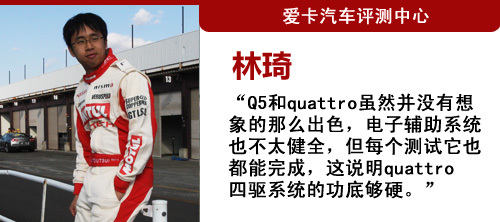
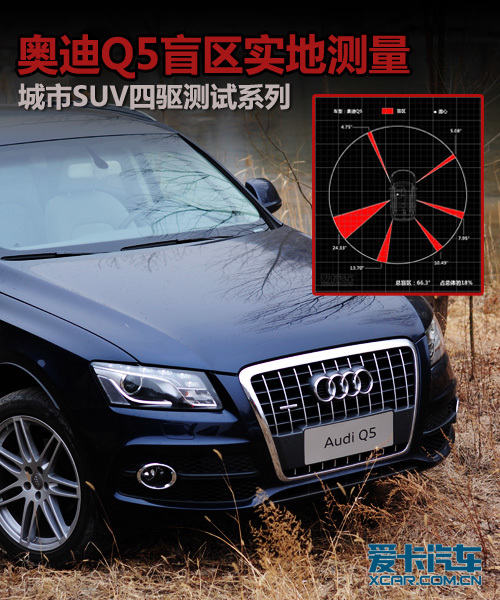
Audi Q5 Blind Zone Test for Urban SUV Four-wheel Drive System Test (click to read the full text)

Cadillac SRX and e-AWD intelligent four-wheel drive for four-wheel drive test(Click to read the full article)
